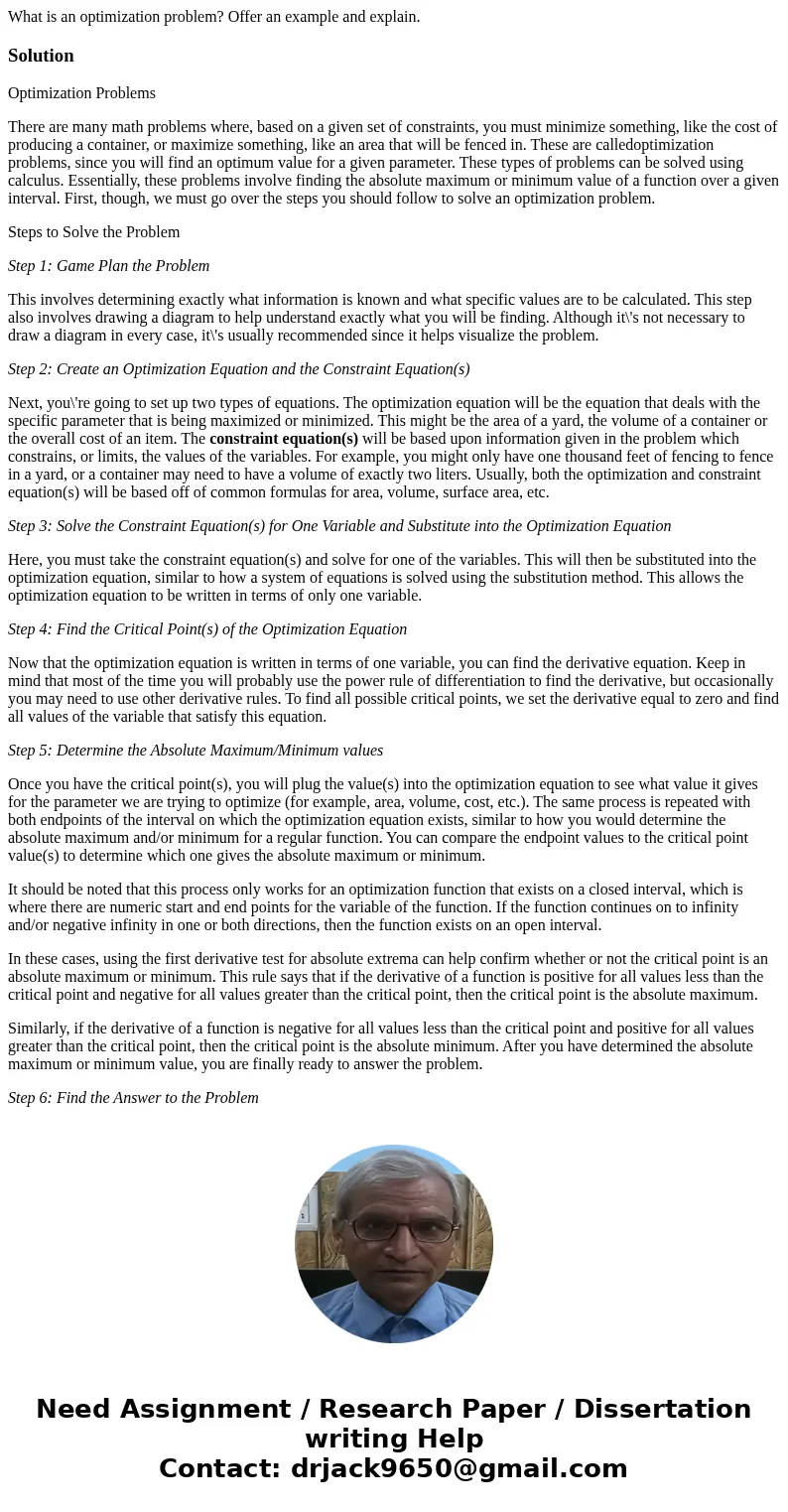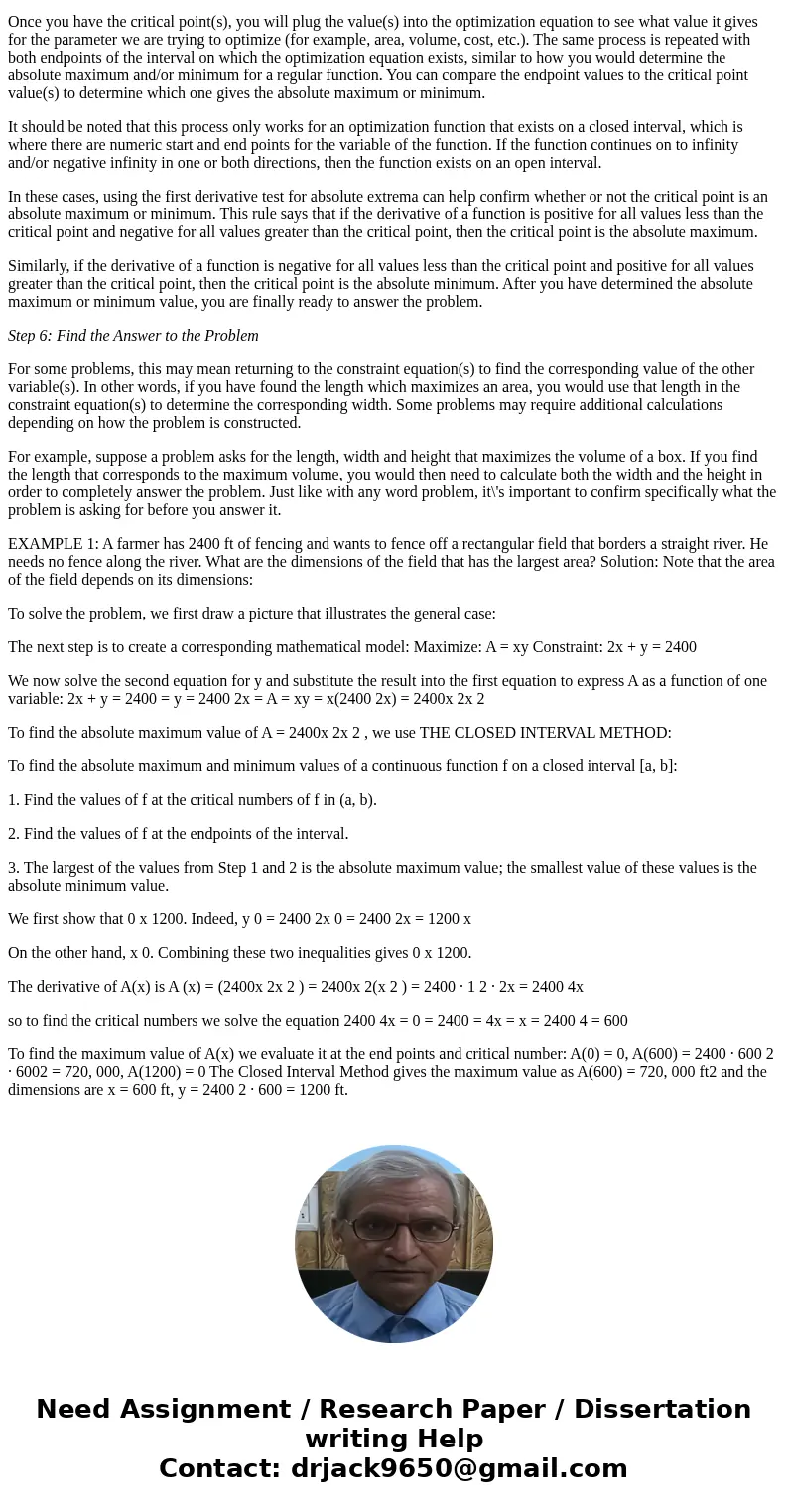What is an optimization problem Offer an example and explain
What is an optimization problem? Offer an example and explain.
Solution
Optimization Problems
There are many math problems where, based on a given set of constraints, you must minimize something, like the cost of producing a container, or maximize something, like an area that will be fenced in. These are calledoptimization problems, since you will find an optimum value for a given parameter. These types of problems can be solved using calculus. Essentially, these problems involve finding the absolute maximum or minimum value of a function over a given interval. First, though, we must go over the steps you should follow to solve an optimization problem.
Steps to Solve the Problem
Step 1: Game Plan the Problem
This involves determining exactly what information is known and what specific values are to be calculated. This step also involves drawing a diagram to help understand exactly what you will be finding. Although it\'s not necessary to draw a diagram in every case, it\'s usually recommended since it helps visualize the problem.
Step 2: Create an Optimization Equation and the Constraint Equation(s)
Next, you\'re going to set up two types of equations. The optimization equation will be the equation that deals with the specific parameter that is being maximized or minimized. This might be the area of a yard, the volume of a container or the overall cost of an item. The constraint equation(s) will be based upon information given in the problem which constrains, or limits, the values of the variables. For example, you might only have one thousand feet of fencing to fence in a yard, or a container may need to have a volume of exactly two liters. Usually, both the optimization and constraint equation(s) will be based off of common formulas for area, volume, surface area, etc.
Step 3: Solve the Constraint Equation(s) for One Variable and Substitute into the Optimization Equation
Here, you must take the constraint equation(s) and solve for one of the variables. This will then be substituted into the optimization equation, similar to how a system of equations is solved using the substitution method. This allows the optimization equation to be written in terms of only one variable.
Step 4: Find the Critical Point(s) of the Optimization Equation
Now that the optimization equation is written in terms of one variable, you can find the derivative equation. Keep in mind that most of the time you will probably use the power rule of differentiation to find the derivative, but occasionally you may need to use other derivative rules. To find all possible critical points, we set the derivative equal to zero and find all values of the variable that satisfy this equation.
Step 5: Determine the Absolute Maximum/Minimum values
Once you have the critical point(s), you will plug the value(s) into the optimization equation to see what value it gives for the parameter we are trying to optimize (for example, area, volume, cost, etc.). The same process is repeated with both endpoints of the interval on which the optimization equation exists, similar to how you would determine the absolute maximum and/or minimum for a regular function. You can compare the endpoint values to the critical point value(s) to determine which one gives the absolute maximum or minimum.
It should be noted that this process only works for an optimization function that exists on a closed interval, which is where there are numeric start and end points for the variable of the function. If the function continues on to infinity and/or negative infinity in one or both directions, then the function exists on an open interval.
In these cases, using the first derivative test for absolute extrema can help confirm whether or not the critical point is an absolute maximum or minimum. This rule says that if the derivative of a function is positive for all values less than the critical point and negative for all values greater than the critical point, then the critical point is the absolute maximum.
Similarly, if the derivative of a function is negative for all values less than the critical point and positive for all values greater than the critical point, then the critical point is the absolute minimum. After you have determined the absolute maximum or minimum value, you are finally ready to answer the problem.
Step 6: Find the Answer to the Problem
For some problems, this may mean returning to the constraint equation(s) to find the corresponding value of the other variable(s). In other words, if you have found the length which maximizes an area, you would use that length in the constraint equation(s) to determine the corresponding width. Some problems may require additional calculations depending on how the problem is constructed.
For example, suppose a problem asks for the length, width and height that maximizes the volume of a box. If you find the length that corresponds to the maximum volume, you would then need to calculate both the width and the height in order to completely answer the problem. Just like with any word problem, it\'s important to confirm specifically what the problem is asking for before you answer it.
EXAMPLE 1: A farmer has 2400 ft of fencing and wants to fence off a rectangular field that borders a straight river. He needs no fence along the river. What are the dimensions of the field that has the largest area? Solution: Note that the area of the field depends on its dimensions:
To solve the problem, we first draw a picture that illustrates the general case:
The next step is to create a corresponding mathematical model: Maximize: A = xy Constraint: 2x + y = 2400
We now solve the second equation for y and substitute the result into the first equation to express A as a function of one variable: 2x + y = 2400 = y = 2400 2x = A = xy = x(2400 2x) = 2400x 2x 2
To find the absolute maximum value of A = 2400x 2x 2 , we use THE CLOSED INTERVAL METHOD:
To find the absolute maximum and minimum values of a continuous function f on a closed interval [a, b]:
1. Find the values of f at the critical numbers of f in (a, b).
2. Find the values of f at the endpoints of the interval.
3. The largest of the values from Step 1 and 2 is the absolute maximum value; the smallest value of these values is the absolute minimum value.
We first show that 0 x 1200. Indeed, y 0 = 2400 2x 0 = 2400 2x = 1200 x
On the other hand, x 0. Combining these two inequalities gives 0 x 1200.
The derivative of A(x) is A (x) = (2400x 2x 2 ) = 2400x 2(x 2 ) = 2400 · 1 2 · 2x = 2400 4x
so to find the critical numbers we solve the equation 2400 4x = 0 = 2400 = 4x = x = 2400 4 = 600
To find the maximum value of A(x) we evaluate it at the end points and critical number: A(0) = 0, A(600) = 2400 · 600 2 · 6002 = 720, 000, A(1200) = 0 The Closed Interval Method gives the maximum value as A(600) = 720, 000 ft2 and the dimensions are x = 600 ft, y = 2400 2 · 600 = 1200 ft.


 Homework Sourse
Homework Sourse